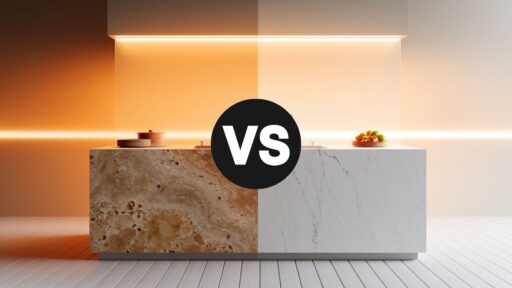Wondering which countertop material will work best in your home?
When comparing sintered stone vs quartz, you’re choosing between two durable engineered surfaces with different strengths.
Sintered stone is newer, made from compressed natural minerals without resins, creating an extremely tough material.
Quartz combines crushed quartz crystals with polymer resins to form hard, non-porous surfaces.
Both look great in kitchens and bathrooms, with designs that mimic natural stone or create unique patterns.
They differ significantly in heat resistance, outdoor durability, and price points.
Understanding these differences helps you choose the right surface, ensuring your investment adds beauty and functionality.
What is Sintered Stone?
Sintered stone is a newer type of engineered surface that’s becoming popular for kitchens and bathrooms.
It’s made from natural minerals that are pressed and heated to create a super-strong material.
Think of it like baking clay in an oven, but with much higher heat and pressure.
The result is a sleek, durable surface that can look like natural stone, concrete, or even metal.
Brands like Dekton, Neolith, and Lapitec are leading the way with sintered stone products.
Sintered stone, unlike other materials, is made without resins or binders, enabling it to endure extreme temperatures and outdoor conditions better than most alternatives.
What is Quartz?
Quartz countertops aren’t made of solid natural quartz like you might think.
They’re actually engineered stone made from crushed quartz mixed with resin and pigments.
About 90-95% is ground quartz crystals, with the rest being polymer resins that bind everything together.
Manufacturers mix these ingredients and then form them into slabs under intense pressure.
The result is a hard, non-porous surface available in various colors and patterns.
Some even resemble marble or granite.
Caesarstone, MSI Q Quartz, and Cambria are some brands that lead in Quartz products.
Quartz has become super popular in kitchens and bathrooms over the last decade.
In modern homes, it can be found in countertops, backsplashes, shower walls, and sometimes even floor tiles.
Sintered Stone vs Quartz: A Side-by-Side Comparison

When choosing between sintered stone and quartz, there are several key factors to consider.
These two popular engineered surfaces have important differences in performance, appearance, and cost.
Let’s break down how they compare in eight critical areas.
1. Appearance and Design Variety
Both materials offer lots of colors and patterns to choose from.
Quartz: It often mimics marble and granite well, while typically offering more color options than natural stone.
Sintered stone: It mimics stone, concrete, metal, or wood while creating larger slabs with fewer seams.
The finishing options, like matte or glossy, are available in both materials.
2. Durability and Resistance
Both will last for decades with proper care.
Sintered stone: It is extremely hard and dense, ranking above quartz and nearly impossible to chip or crack.
Quartz: It is very durable but can chip at the edges when hit with heavy objects.
For everyday use, both materials stand up well to normal wear and tear.
3. Heat and UV Resistance
Heat and sun exposure reveal key differences between these two countertop materials.
Sintered stone: It handles heat well and won’t fade in sunlight, and its biggest advantage is its heat resistance.
Quartz: It can scorch from high heat and yellow or fade when exposed to direct sunlight for long periods.
For outdoor applications or high-heat cooking, sintered stone clearly outperforms quartz in durability.
4. Scratch and Stain Resistance
Both materials resist scratches better than natural stone like marble.
Sintered stone: It is virtually impossible to scratch with normal kitchen tools or activities.
Quartz: It can be scratched by very sharp objects or extreme force.
Both non-porous materials resist stains from red wine, coffee, and oil when wiped up within a reasonable time.
5. Installation Requirements
Both materials need professional installation due to their weight and cutting requirements.
Sintered stone: It is lighter, comes in larger slabs, and requires special tools and training for installation.
Quartz: It is heavier and needs sturdy cabinet support underneath.
Both materials can be undermounted with sinks and offer various edge profile options.
6. Cost Comparison
Both are investment materials that cost more than laminate but less than rare natural stones, and they have similar installation costs.
Sintered stone: Typically $60-$200 per square foot with advanced performance benefits.
Quartz: Depending on the brand, it typically costs between $40 and $100 per square foot installed.
The price difference often justifies sintered stone’s superior heat resistance and durability for demanding applications.
Note: These are estimated costs that can vary by location, supplier, and market conditions. Prices may change over time due to material availability and demand.
Performance in Different Applications
Both sintered stone and quartz are tough materials with different strengths for different uses.
Here’s how they perform in real-world situations.
| APPLICATION | SINTERED STONE | QUARTZ |
|---|---|---|
| Kitchen Countertops | Won’t scratch or burn. Easy to clean. No stains. | Looks great. Handles daily use. Hot pans damage it. |
| Bathroom Vanities | Water and soap are safe. Stays new-looking. | Popular choice. Many colors. Easy cleaning. |
| Outdoor Applications | Sun, rain, and cold won’t damage it. Great outdoors. | Fades in sunlight. Better for indoors only. |
| Commercial vs Residential | Handles heavy daily use. Very strong. | Good for homes. Shows wear in busy places. |
Sintered stone handles tough conditions better, while quartz offers more designs and costs less.
Choose what meets your needs and usage plans.
Sustainability & Environmental Impact
When you’re choosing between sintered stone vs quartz, both options are pretty good for the environment.
Sintered stone is made from natural minerals and uses less energy during production.
Plus, it’s completely recyclable when you’re ready to replace it years down the road.
Quartz countertops do contain some recycled materials, usually around 10-15%, but they need more energy and chemicals to manufacture.
Both materials will last for decades in your kitchen, which means you won’t be replacing them anytime soon.
That’s great for the planet. If being eco-friendly is your main concern, sintered stone has a slight advantage.
But honestly, both are solid choices that won’t harm the environment much.
Maintenance Tips
Both sintered stone and quartz are easy to take care of with simple daily habits.
- Clean both surfaces with warm soapy water, avoiding harsh cleaners or bleach.
- Wipe spills immediately, especially on quartz which stains more easily than sintered stone.
- Always use trivets or hot pads since quartz is more prone to heat cracking.
- Use cutting boards on both materials, though sintered stone handles knives better.
- Clean monthly with gentle products and avoid rough scrubbers that dull surfaces.
With regular care, both materials stay beautiful for many years. Sintered stone is more forgiving overall.
Which One Should You Choose?

Picking the right option can feel overwhelming with so many choices out there.
Start by thinking about what you really need, not just what looks cool.
Consider your budget too – sometimes the cheapest isn’t the best value, but you don’t always need the most expensive either.
Ask yourself how you’ll actually use it day-to-day.
Will it fit your lifestyle?
Reading online reviews can help, but remember that everyone’s needs are different.
Don’t rush your decision.
Take your time, compare a few options, and trust your gut feeling.
The perfect choice is the one that works best for your specific situation.
Summing It Up
When deciding between sintered stone vs quartz, consider your daily habits and needs.
Sintered stone excels with heat resistance—hot pans won’t damage it—and performs perfectly outdoors without fading.
Quartz typically offers more color options and costs less, making it ideal for indoor spaces where you want beauty without the highest price tag.
Both resist stains, clean easily, and don’t require sealing like natural stone.
Think about your cooking style, if you need outdoor surfaces, and your budget.
The perfect choice matches your specific lifestyle requirements and how you’ll use the space every day.
So, which team are you joining—Team Sintered Stone or Team Quartz?
Tell us in the comments below!
If you’re interested in more informational home decor content, feel free to click here and explore our other blogs that might catch your interest.








